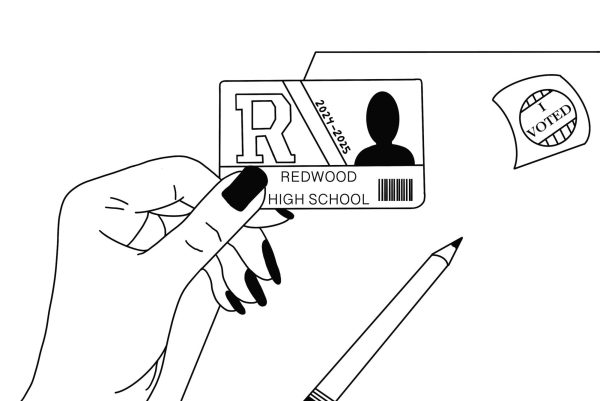My parents love to tell me to take initiative with my education, and I love to tell them that that is easier said than done. At Redwood, the sad truth is that students have no say in decisions about their education and the happenings of their school. In the Tamalpais Union High School District (TUHSD), students are essentially powerless in important decisions made about the school with no way to elect representatives onto the school board and a politically powerless student government. In other school districts, such as the Berkeley Union High School District, students aged 16 to 17 are welcomed into polling places to participate in the democratic process that most directly affects their lives.
In TUHSD, it seems to students as if the school board just doesn’t care about their opinions. The proposed Yondr pouch plan during school hours has the support of only one percent of surveyed TUHSD students according to a recent district-wide survey. To students, the survey only seems performative, a weak attempt by the board to display interest in student opinion with no real care for what students think. In the same hemisphere, an October Bark survey showed that 63 percent of students disagree with decisions made by the school board, such as decisions to restrict certain elective classes. Students should be able to vote in school board elections as they face unequal representation in school decisions and are unable to participate in democratic processes directly affecting their lives.
With a median age of 48.4, many TUHSD voters haven’t been in high school for 30 or more years. In 1994, the world was a vastly different place. Bill Clinton was elected president and the Public Broadcasting Service released the hit TV show “The Magic School Bus.” While one could argue that Ms. Frizzle transcends time, the early 1990s high school experience does not. TUHSD needs a breath of modernity from voters who are directly affected by board decisions. It’s easy for a wealthy 60-year-old southern Marin resident to vote for a board candidate who may promise no increase in taxes for residents rather than someone who advocates greater funding for schools at the taxpayer’s expense. This is because your average 60-year-old living in southern Marin is not in high school, and does not sit in their English class with no air conditioning when it is more than 90 degrees outside and 35 other kids are in the same class. TUHSD needs voting from its own constituents because they understand the current issues that plague TUHSD schools: low student morale, exhaustion and lack of engagement.
Moreover, only one current school board candidate has a child of school age. Why aren’t we electing candidates who are in touch with matters in our schools? Why aren’t we electing candidates who have a means of being in touch with the youth? One could reference the older voting base as a reason. A Gallup poll conducted between 2015 and 2018 revealed that as students get older and progress through high school, engagement in the classroom plummets compared to their prior grade school education. Students know what they want, and what they want is a better way to be engaged in their education than TUHSD provides.

Imagine this: The most powerful country on earth provides minimal voter education to its youth, then immediately expects them to be able to make potentially the most important decisions of their lives about who controls one of the largest numbers of nuclear warheads on Earth. This might sound familiar because it describes democracy in the United States. In a country so heavily based on democratic ideals, civic engagement in high school is imperative. In the United States and especially at Redwood, there are limited opportunities for students to put education about civic engagement into practice. In its mission statement, the school board claims that one of its purposes in developing a student’s character is civic engagement — and it can do this by allowing students to vote in school board elections.
School board elections are decidedly smaller-scale than presidential elections and introduce students to the ideas of political thought and research, an essential part of a well-rounded citizen. Voting in small-scale elections like school board elections demonstrates to students that their votes matter. In TUHSD, elections are often won by small margins, meaning that a student could sway the election with their vote.
The TUHSD mission statement claims that the board aims to maintain a student’s intercultural competence by “Advocating for a just and democratic society for all people.” The board phrased it best themselves; a just society includes democracy for all people. My education at Redwood has instilled this core belief in me, yet the hypocrisy of the false statement made by leaders is unfortunately all too clear. In the U.S., students have some of the most direct representation in the world. For example, TUHSD students have a ratio of one elected official (representative) for every 946 students. Some of, if not the most direct representation voting-age citizens have is in their city council members. In Larkspur, we have a ratio of one elected official for every 3188.5 citizens. These statistics provide evidence for the fact that as students, we are some of the most directly represented individuals in America, yet we have no access to our representation. Instead, we are at the mercy of foreign individuals. The sentiment is similar to revolutionary America, where our forefathers had an unfortunate lack of representation in their own affairs. While our plight is decidedly less large-scale and unfortunate, it nonetheless bears a striking resemblance. Our tiny island across the sea is a group of individuals who have never been in the modern high school system, yet make decisions for us. I would argue that a Redwood education paints the founding fathers in a mostly positive light; why shouldn’t we follow their moral example?
What followed the revolution was an unfortunate, but necessary period of internal conflict. A big and valid fear of anti-federalists (anti-national governmentalists) was the tyranny of the majority. With students voting for the school board, this wouldn’t be a factor, as students would not be able to present a majority. In TUHSD, 94,767 citizens are over 18, meaning they are eligible to vote. If TUHSD sophomores, juniors and seniors could vote, only 3,658 new voters would be eligible to vote in school board elections. This means that public opinion won’t be disregarded, but neither will student opinion. Students have the opportunity to sway an election, but only with popular support. Anti-federalists also feared that a central government would levy high taxes on the common man, leading to financial ruin and misuse of funds. An unfortunate implication of student suffrage is the introduction of slightly higher taxes to fund the student’s ability to vote. Your average childless Marin resident is already reluctant to vote for the tax hike that comes with Measure B and is unlikely to find the idea of an additional tax appealing. It’s important to remember that the investment in student suffrage is not only an investment in students, but an investment in America’s future. The ability to vote in elections at such a young age leaves students with the lasting value of the importance of democracy. It teaches students that their vote matters. The ability to vote teaches students that they are an integral part of American democracy, making them more productive citizens in the long run.
Many federalists in revolutionary America were rich aristocrats who felt that the common man was too naive to be able to make productive decisions. One could argue that students are too naive and potentially unwilling to research to elect a candidate in their youth. However, at Redwood, students seem eager to do the research and vote for a candidate. In an October Bark survey, 59 percent of students said they would like to be able to vote in school board elections. While currently, students might not be likely to make themselves educated on board matters, the introduction of voting for students would be a unique feature of the Tam district, meaning there would likely be an element of pride among students. This would encourage students to value their unique abilities and privileges, potentially making them more likely to educate themselves on matters of the local and school community.
If TUHSD truly values student opinions, the board should be eager to implement student suffrage. The ability for students to vote in school board elections shows the community what truly matters to students and gives them a consistent voice and an introduction to democratic values. Not only is it an educational opportunity, but it is also an opportunity to put TUHSD at the forefront of progress. I think it’s important to finish by asking the board a simple question: are you willing to invest in the future of your students and democracy?








